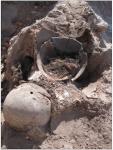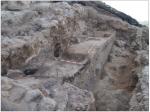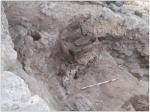Summary (English)
The intervention carried out in 2011 in the site of Cabezo Redondo was carried out within the framework of the Proyecto de puesta en valor del yacimiento de Cabezo Redondo. IA phase. Departments XIX, XXV, XXVI and XXVII funded through the 1% Cultural Programme of the Ministry of Public Works and Transport with the collaboration of Generalitat Valenciana. The archaeological intervention was focused on three areas of the site, including the domestic spaces previously described.
The works carried out have been the complete or partial excavation of those areas affected by the project or those whose subsequent excavation could have deteriorated the already excavated elements, as well as the monitoring of any of the actions which the restoration process implies.
The most relevant intervention, in terms of complexity and results, has been the complete excavation of the upper part of the rooms XXVI and XV, with the aim of settling the foundation of a roof over this last space, destined to protect a valuable ensemble of constructions built with clay. This intervention has allowed the definition of a new domestic space, which has been named room XXX, in the tradition of the designations used on the site.
The characteristics of this room are fully integrated in the typical constructive system of this settlement, with dwellings ordered in artificial terraces. It is a construction with a rectangular floor which shares one of the closing walls with the spaces of the lower terrace -rooms XXV and XXVI. A series of post holesfor the support of the the roof was detected excavated through the pavement and the levelling filling. These structures are usually circular, and built with different sized stones, which delimit a central circular hollow space, whose upper part is covered with a thick coat of clay.
The only documented level of occupation covered a thick level of anthropic fill formed by layers of earth of different compositions, some of them containing numerous archaeological materials. No remains were registered during the excavation process, which could indicate the existence of previous phases. The constructive elements associated with this occupation are a poorly preserved pavement in some points, as well as a complex system of banks attached to the walls and built with small sized masonry covered by a thick layer of plastered mud. Within these constructions a quadrangular stand 0.7 m high stands out, with a sunken upper part acting as a cuvette and with a mill integrated in the centre.
The materials belonging to this level are abundant due to the destruction of the house in a fire. Numerous whole ceramic containers have been recovered, as well as tools made from stone, bones and metal. Grass mats and carbonised cereal seeds have also been found, which will allow the dating of the moment of destruction and abandonment.
The archaeological monitoring
resulting in excavation in certain caseshas been continuous throughout the whole project. The land removal in the preparation process of the site or the placing of the roof of room XXV has been supervised, as well as the cleaning originated by the restoration that implied action over sedimentary reservoirs.(translation by Andrea Jorde Pérez)
- Virginia Barciela González y Eduardo López Seguí
Director
- Eduardo López Seguí (Alebus Patrimonio SL)
- Mauro Severo Hernández Pérez (Universidad de Alicante)
- Virginia Barciela González (Universidad de Alicante)
Team
- Israel Espí Pérez, Adela Sánchez Lardíes e Ignasi Segura Martínez
- Museo Arqueológico Municipal José María Soler
Research Body
- Alebus Patrimonio SL
- Colegio Oficial de Doctores y Licenciados en Filosofía y Letras y en Ciencias de Alicante - Sección de Arqueología
- Universidad de Alicante
Funding Body
- Dirección General de Patrimonio de la Generalitat Valenciana
- Programa del 1% Cultural del Ministerio de Fomento, Gobierno de España






![Download [PDF]](/excavation/skins/fasti/images/results/download_sml.png)

